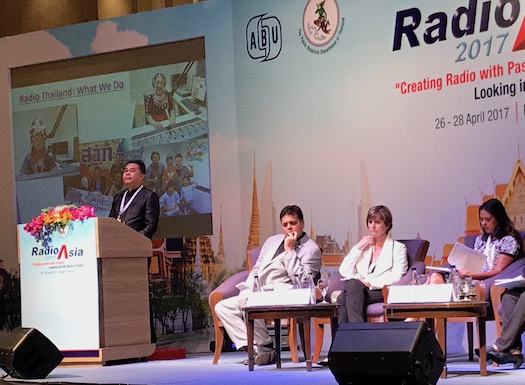On the third day of this year's Radio Asia conference, delegates heard about one of the host country’s major stations, Radio Thailand.
The network was founded in 1930 as a public service radio station for the government to disseminate information and communication to the people.
Charoon Chaisom (pictured above), head of the PR Department which runs the network, said the station operated a total of 147 stations nation wide on FM, AM and SW frequencies.
Radio Thailand Bangkok is the head-of-network station, with regional network stations also producing local talk content, working with local staff and volunteers to cover local events.
The network also involves youth and disadvantaged people and aims to “instill good values in people.”
“We are always aware that we must reach out and serve our audiences. We are striving to be more than radio, bridging the gap between policy makers and the people, in every part of the country.
“We also reflect the needs and ideas of local people back to the government,” explained Chaisom.
Radio Thailand also supports people in times of emergencies and other needs.
“We now live in a digital era, where communications are combined into a single device. This changing time has made it more crucial to reach listeners on many platforms and to be on everyone’s mind.”
The network is working hard to adapt to the new environment to “maintain our identity as a primary source of news and information in this digital area.”
In the following session, discussing challenges to the modern radio industry, Commercial Radio Australia’s Joan Warner (left) said one of the biggest challenges facing radio is fear.
The changing media environment has made some radio companies afraid of the new competition, but Warner says there is no need to be afraid.
“People look around and ask, how can we compete. The new services seem shiny and new, they attract attention… radio does not always get the attention it deserves.
“To counter this the radio industry needs to come together and raise the profile of radio, and keep themselves top of mind with stakeholders and advertisers.
“We also have a fantastic opportunity with our content, we have so much content, we can use and reuse it to keep people more engaged with radio by repurposing it on different platforms.
“To counter some of the, sometimes misleading, information about those shiny new services, radio needs good research into how may people are listening and how long they are spending with radio in comparison with other audio services. We need to remind people that they can trust radio with their content and with their brands… We must fly the flag for radio with real figures and true information.”
RRI’s Dwi Hemuningsih (right), in her session, talked about how Radio Republik Indonesia is countering fake news.
“True information is very necessary in my country. We need to make radio the social media of first choice,” she said.
Discussing how RRI is now using its trusted brand on social media to counter fake news, she said “social media has positive and negative impacts. There have been many hoaxes, which are harmful to people and the population as a whole.”
“Broadcast radio has a responsibility to expose hoaxes,” she said.
Shammi Lal (left), Program Manager of Fiji Broadcasting Corporation talked about the success of her stations on the little pacific island of Fiji, which has a population of less than one million people.
She outlined some of the challenges faced by FBC, such as “people replacing radio listening with personalised playlists on music streaming services.”
Other challenges also include watching videos on smartphones, satellite and internet radio stations, and the advertisers sense that there is a changing share of ear. “Our share of advertising is affected by all these things.”
FBC also introduced Fiji’s first local tv station two years ago, and the radio FBC radio stations have had to adjust to the introduction of tv. Fortunately, since FBC owns the tv channel, the company’s radio stations have had the opportunity to make cross platform programs, whcih is helping drive audience share.
“We need to spend time thinking about what is happening in the industry and find the unique value of our stations to reposition radio for the benefit of the industry and our advertisers.
“People want personality and local insights. They want presenters who will become their friend. We try to ensure our radio stations give them that.”
The stations have risen to the challenge through activities including promotional visits, sales visits and OBs to many towns.
The station has street frontage and each studio has a window that people can look in and see the broadcasters on air. The stations have used the windows to display messages, art work and other campaigns.
In a recent Easter promotion, hot crossed buns with station logos on them were given out at traffic lights. “We went up to the car windows, gave them to the audience through the window and asked please listen to us.”
The station has also recently embarked on a campaign to counter racial profiling and build inclusiveness for the Pacific island nation. In the campaign, Fijians spoke Hindi to give message of inclusion and Fijian Indians spoke Fijian in messages of racial harmony.

